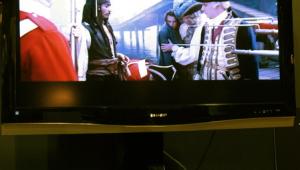One On One With Paramount's Alan Bell

Right or wrong, many people won't look past the money story. But Paramount's Chief Technology Officer Alan Bell (pictured above, with the author) was kind enough to sit down with me at CEDIA and explain some of the reasons he recommended that Paramount make this move.
First and foremost, Alan is not part of the business end of things at Paramount. So questions of subsidies and/or financial incentives regarding Paramount's Blu-ray participation and current pro-HD DVD stance are not ones he can answer. But Alan did tell me that as CTO, his opinion played a role in making the move and that supporting HD DVD was indeed his firm recommendation.
Regarding what went into that decision Alan reiterated some things that have been written elsewhere, including HD DVD's stable set of specifications, advanced interactivity, and the difficulty of authoring and replicating Blu-ray Discs.
Alan's position is that Paramount would undoubtedly like to get more involved in advanced interactivity (think Transformers), and that right now the limited capabilities and multiple hardware platforms on Blu-ray would make it difficult to offer these features on both formats and market them properly.
Alan believes that one of the things that makes HD DVD's web enabled interactivity unique is that it offers a transition between physical media and the download world. On top of that, the surface hasn't even been scratched as far as merchandising and other revenue streams that could result. While Blu-ray Discs will start offering networked interactivity late this year or early next, Alan feels the current situation is poor given that most of the third-gen standalone BD players don't support these features.
During our meeting, to illustrate Alan's point that the authoring for BD discs is far more complicated (and therefore expensive), Microsoft's Kevin Collins showed us a graphic purported to be the code required to author a chapter jump on an HDi-authored HD DVD disc and the Java code required to author the same operation on a Blu-ray Disc. The HDi code appeared to be several lines long, while the Java code filled almost an entire page. Time is money in the authoring world, as in so many other walks of life.
Among the things I asked Alan was whether at any point he had the idea that Blu-ray would offer interactivity features that were superior, which might provide a payoff for the increased difficulty. He said that while something could came up down the road, he is not currently aware of anything, beyond an additional layer of copy protection, which offers no benefit to consumers.
Alan also believes that HD DVD has much greater capability to ramp up to massive scale for HD releases. There are more replciation lines available for HD DVD, and because of its similarity to DVD bringing new lines up for HD DVD will be faster, cheaper and easier.
HD DVD is already achieving significantly higher yields in replication at much lower costs. Alan also explained that bringing a replication facility online for Blu-ray requires a massive up front expenditure in equipment, and once that's complete that line is Blu-ray Disc only. HD DVD replication requires something more along the lines of a retrofit, is cheaper by several orders of magnitude, and that same line can still replicate DVDs, offering greater utility.
When I pointed out that most of this was known over a year ago, when Paramount embarked on the dual-format platform, Alan's response was interesting. He said that knowing something on paper is much different than experiencing it firsthand. He described Paramount's year-long foray in dual format releases as offering invaluable experience which led to the decision to back HD DVD. He also felt that Blu-ray's 50GB capacity hasn't panned out to be the qualitative advantage it was supposed to be with the next-gen audio and video codecs.
Overall, Alan's message was that HD DVD represents the simplest and most cost effective way for Paramount to offer the best HD experience to consumers, and that HD DVD will in turn remain more cost effective for consumers, which will bring more people to adopt HD in general.
- Log in or register to post comments
























































